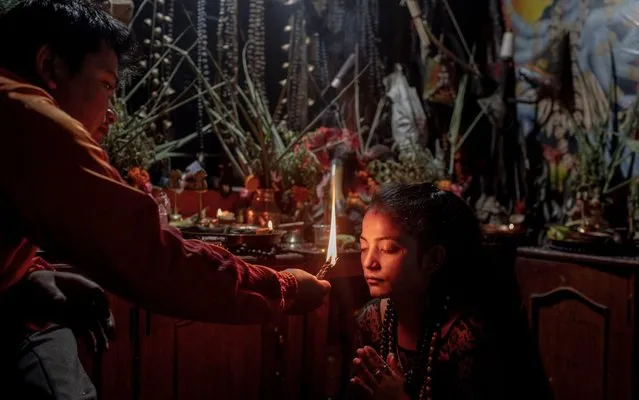
Chet Bahadur Thing (L), aged 26, a renowned shaman in the ethnic Tamang community, transforms aspiring shaman Sheela Lamichhane's evil spirit into a good spirit after the completion of a ritual in Kathmandu, Nepal, 05 September 2019. Shamans, or “Jhakri”, as they are known in Nepal, are healers who provide spiritual and physical healing and cleansing. Using a combination of Hindu worship, mantras, meditation and traditional herbal remedies, the shamans are believed to help people who have been unable to find a cure through modern medicine or who have become possessed by spirits. (Photo by Narendra Shrestha/EPA/EFE/Rex Features/Shutterstock)
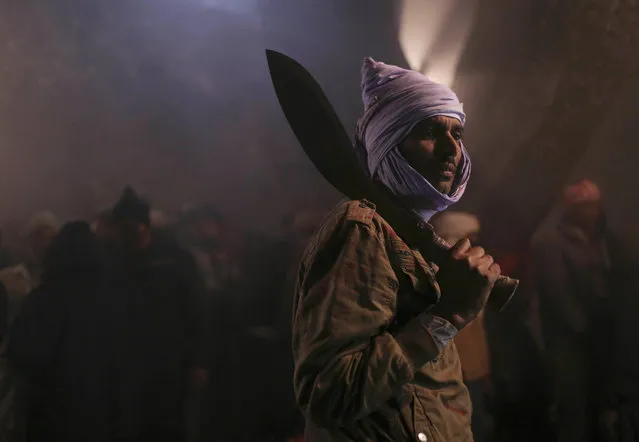
A butcher gets ready to sacrifice animals during Gadhimai festival in Bariyarpur in Bara district 80 miles (50 miles) south of Kathmandu, Nepal, Tuesday, December 3, 2019. Hundreds of thousands of Hindus have gathered at a temple here for a ceremony involving the slaughter of thousands of animals. (Photo by Samir Shrestha/AP Photo)
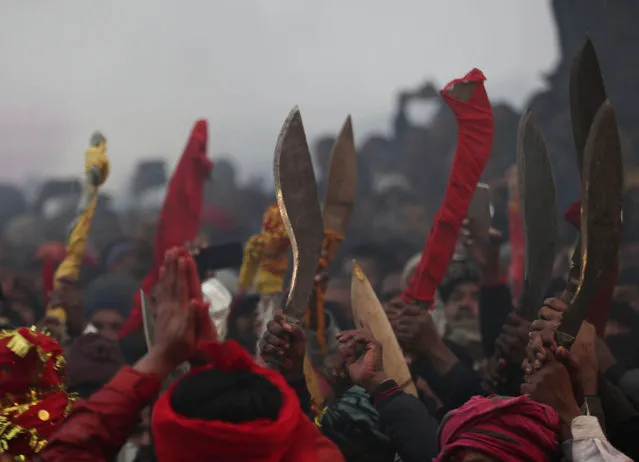
Hindu devotees raise their sacrificial blades as they gather to sacrifice buffalos during Gadhimai festival in Bariyarpur in Bara district 80 miles (50 miles) south of Kathmandu, Nepal, Tuesday, December 3, 2019. (Photo by Samir Shrestha/AP Photo)
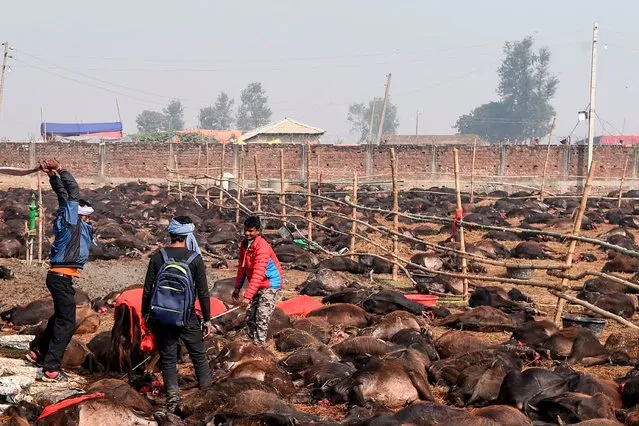
A Hindu devotee slaughters a buffalo as an offering to Hindu goddess Gadhimai during the Gadhimai Festival in Bariyarpur, 160 kms south of the capital Kathmandu on December 3, 2019. The stench of raw meat hung in the air and pools of blood dotted the muddy ground on December 3 as what is thought to be the world's biggest animal sacrifice swung into action in a remote area of Nepal. (Photo by Prakash Mathema/AFP Photo)
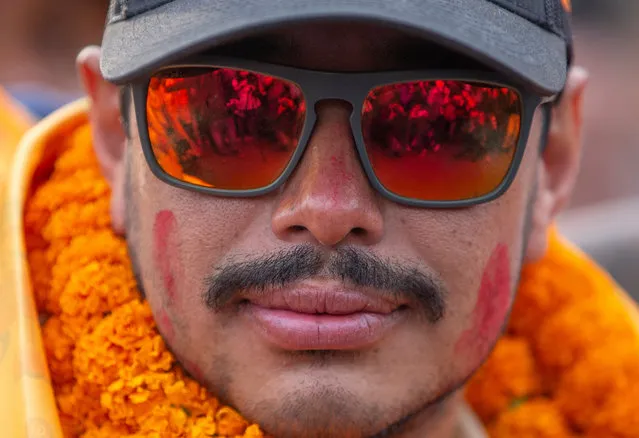
Nepalese mountaineer Nirmal Purja speaks upon his arrival at Tribhuvan International Airport in Kathmandu, Nepal, 30 October 2019. According to media reports, Nirmal Purja completed a record breaking feat after climbing all the world's peaks above 8,000m in under seven months. Nirmal Purja completed his last climb on Mount Shishapangma in China, with an altitude of 8,027 metres above sea level, on 29 October. (Photo by Narendra Shrestha/EPA/EFE)
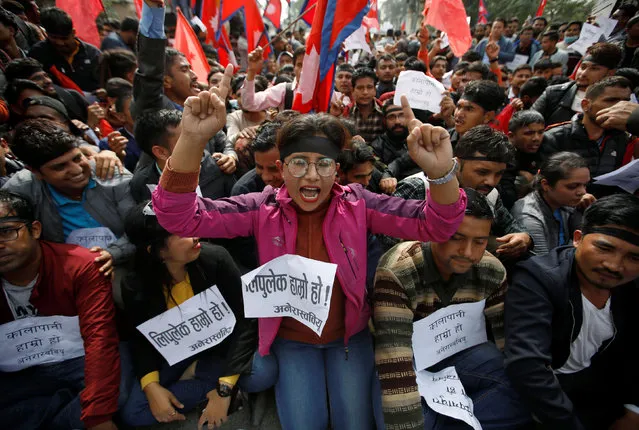
Nepalese students protest against the new map of India near the Indian Embassy in Kathmandu Nepal on November 8, 2019. (Photo by Navesh Chitrakar/Reuters)
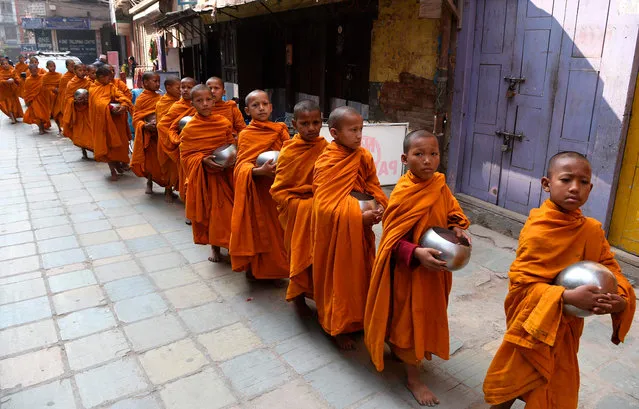
Nepali Buddhist monks hold metal alms pots as they march through an alley near Durbar Square in Kathmandu on November 20, 2019. (Photo by Prakash Mathema/AFP Photo)
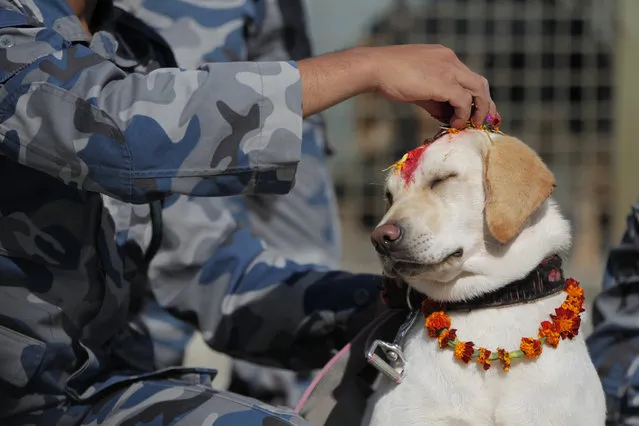
A Nepalese police person puts vermillion powder on the forehead of a police dog as part of worship during Tihar festival celebrations at a kennel division in Kathmandu, Nepal, Sunday, October 27, 2019. Dogs are worshipped to acknowledge their role in providing security during the second day of Tihar festival, one of the most important Hindu festivals that is also dedicated to the worship of Hindu goddess of wealth Laxmi. (Photo by Niranjan Shrestha/AP Photo)
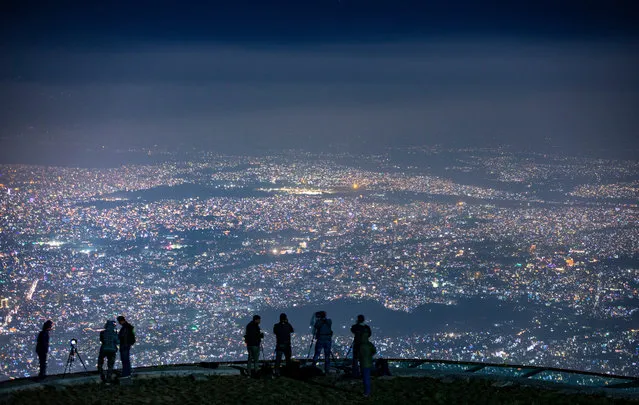
A general view of Kathmandu during the Diwali festival, the “festival of lights”, also known as Tihar celebration in Kathmandu, Nepal, 27 October 2019. The Tihar festival is the second major festival for Nepalese Hindus and it celebrates the victory of light over darkness. (Photo by Narendra Shrestha/EPA/EFE)
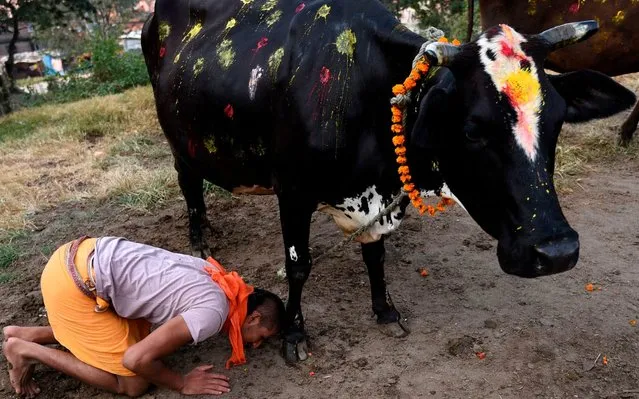
A Hindu devotee worships a cow – regarded as an incarnation of the Hindu Goddess of prosperity Laxmi – during Tihar, the festival of lights that is celebrated at the same time as Diwali, in Kathmandu on October 28, 2019. Hindus across the country worship cows on the third day of the Tihar festival which commemorates the time when Hindu god Lord Rama achieved victory over Ravana and returned to his kingdom after 14 years in exile. (Photo by Prakash Mathema/AFP Photo)
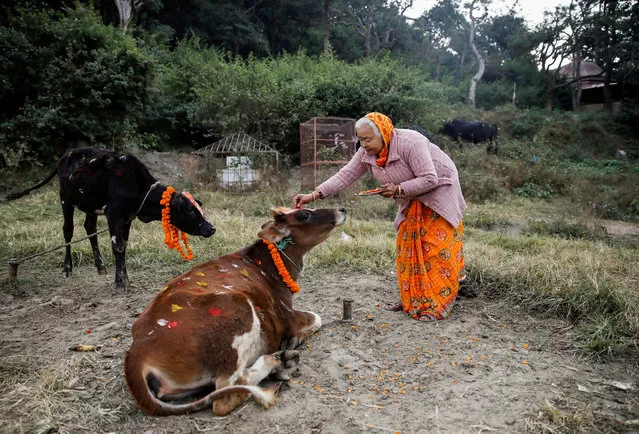
A woman offers prayers to a cow during a religious ceremony celebrating the Tihar festival, also known as Diwali, in Kathmandu, Nepal on October 28, 2019. (Photo by Navesh Chitrakar/Reuters)
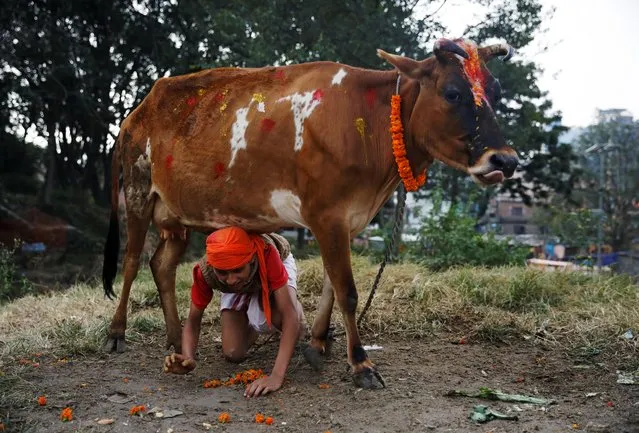
A young Hindu priest crawls under a cow during a religious ceremony celebrating the Tihar festival, also known as Diwali, in Kathmandu, Nepal on October 28, 2019. (Photo by Navesh Chitrakar/Reuters)
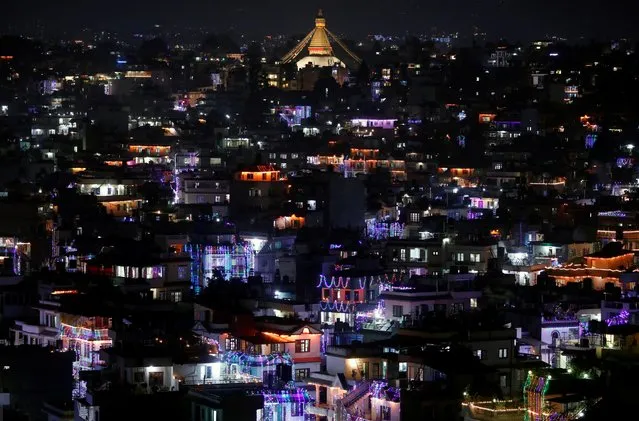
A general view shows houses decorated with lanterns and lights during the Tihar festival, also called Diwali, the Hindu festival of lights in Kathmandu, Nepal on October 26, 2019. (Photo by Navesh Chitrakar/Reuters)
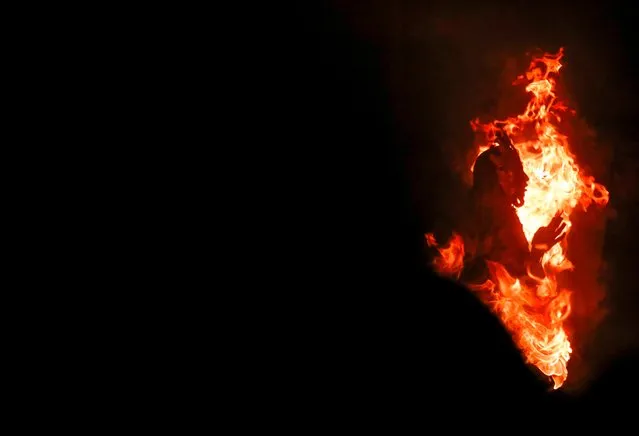
A medium dressed as a deity stands near the fire as he performs during the traditional Kartik Dance Festival at Patan Durbar Square in Lalitpur, Nepal on November 11, 2019. (Photo by Navesh Chitrakar/Reuters)
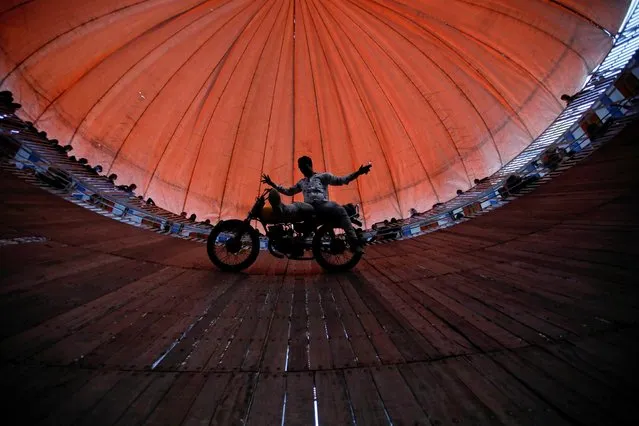
A stuntman performs on the well of death during the “Gadhimai Mela” festival at Bariyarpur in Nepal on December 4, 2019. The festival, renowned for its large number of animal sacrifices, is held every five years at the Gadhimai Temple where devotees from Nepal and bordering India will sacrifice buffaloes, goats and birds while offering prayers to Gadhimai, the goddess of power. (Photo by Navesh Chitrakar/Reuters)
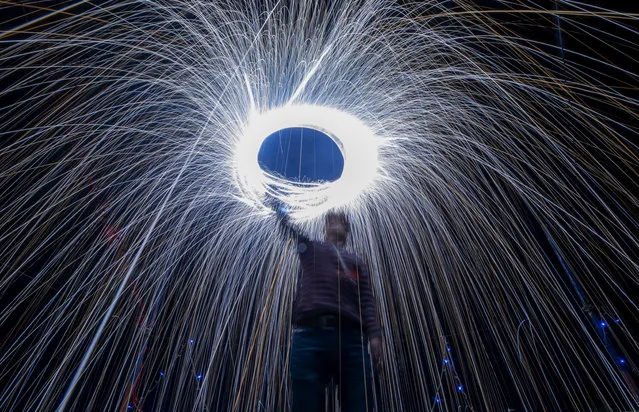
A Nepalese youth plays with sparkles during Deepawali (Diwali), the “festival of lights”, also known as Tihar celebration, in Kathmandu, Nepal, 28 October 2019. Tihar is the second major festival for Nepalese Hindus and celebrates the victory of light over darkness. (Photo by Narendra Shrestha/EPA/EFE/Rex Features/Shutterstock)
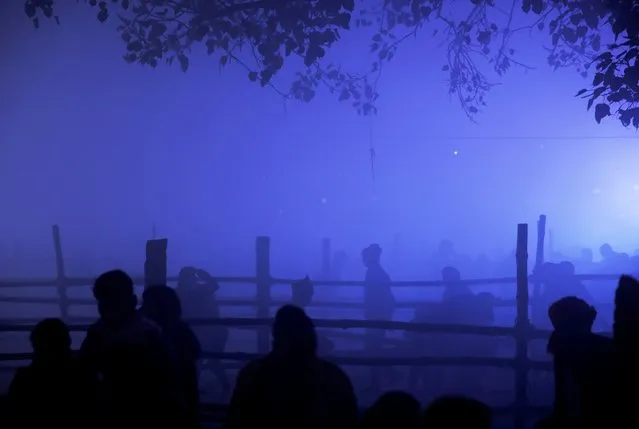
Devotees walk near the temple during the “Gadhimai Mela” festival held in Bariyarpur, Nepal on December 2, 2019. The festival, renowned for its large number of animal sacrifices, is held every five years at the Gadhimai Temple where devotees from Nepal and bordering India sacrifice buffaloes, goats and birds while offering prayers to Gadhimai, the goddess of power. (Photo by Navesh Chitrakar/Reuters)
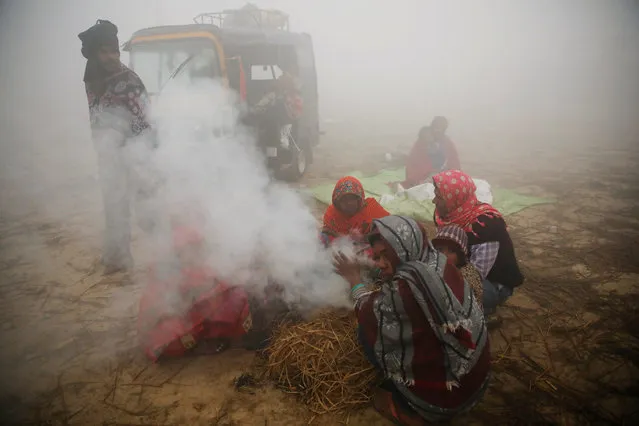
Devotees gather near the fire to keep them warm during the “Gadhimai Mela” festival held in Bariyarpur, Nepal on December 2, 2019. (Photo by Navesh Chitrakar/Reuters)
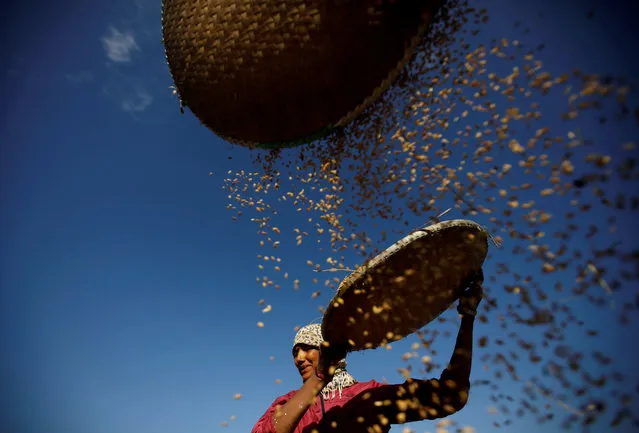
A farmer harvests rice on a field in Lalitpur, Nepal on November 15, 2019. (Photo by Navesh Chitrakar/Reuters)

A Nepalese woman collects Makhmali flowers, an typical flower for Diwali, also known as Tihar festival, in the village of Ichangu, Kathmandu, Nepal, 25 October 2019. The Makhmali flower is mostly used for garlands to worship gods and animals during the Tihar festival. Starting from 27 October 2019, the five-day festival is the second major event for Nepalese Hindus. During the celebrations, people worship crows, considered to be messengers of human beings, dogs, repaying the love towards man's best friend, and cows, considered as incarnation of Lord Laxmi, God of Wealth. (Photo by Narendra Shrestha/EPA/EFE)
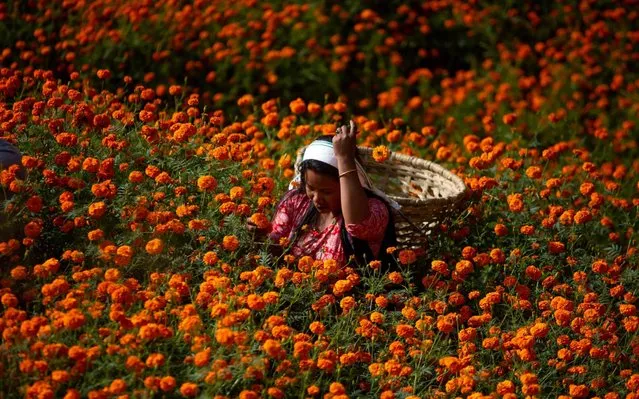
A woman collects marigold flowers for the upcoming Tihar (Diwali) festival in Ichangu Narayan village, on the outskirts of Kathmandu on October 25, 2019. Tihar (Diwali), known as the festival of lights, is a five-day Hindu festival celebrated in late autumn during which various forms of animals are worshipped. The festival is also celebrated in honour of the Hindu goddess Laxmi, the goddess of wealth. (Photo by Sulav Shrestha/Xinhua News Agency)
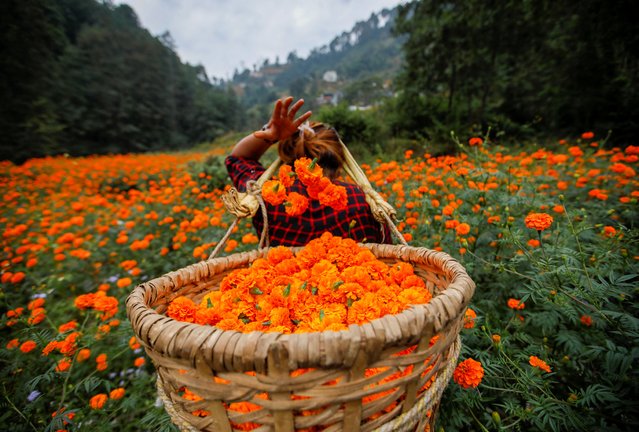
A woman fills her basket with marigold flowers, used to make garlands and offer prayers, as she plucks them before selling to the market for the Tihar festival, also called Diwali, in Kathmandu, Nepal on October 25, 2019. (Photo by Navesh Chitrakar/Reuters)
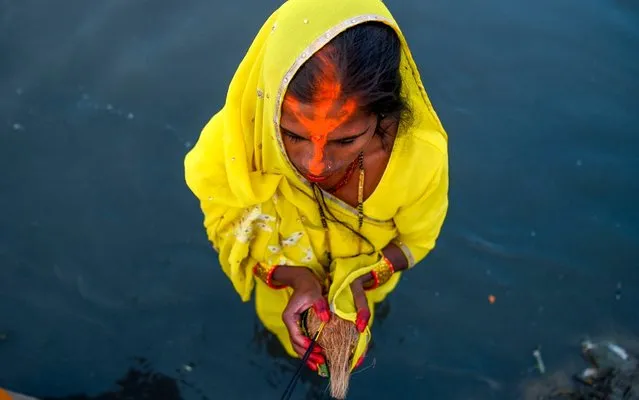
A Hindu devotee takes part in a ritual to worship the sun god during the Chhath Puja Festival in the Bagmati River in Kathmandu on November 2, 2019. The Chhath Festival, also known as Surya Pooja, or worship of the sun, is observed in parts of India and Nepal and sees devotees pay homage to the sun and water gods. (Photo by Prakash Mathema/AFP Photo)
07 Dec 2019 00:03:00,
post received
0 comments
